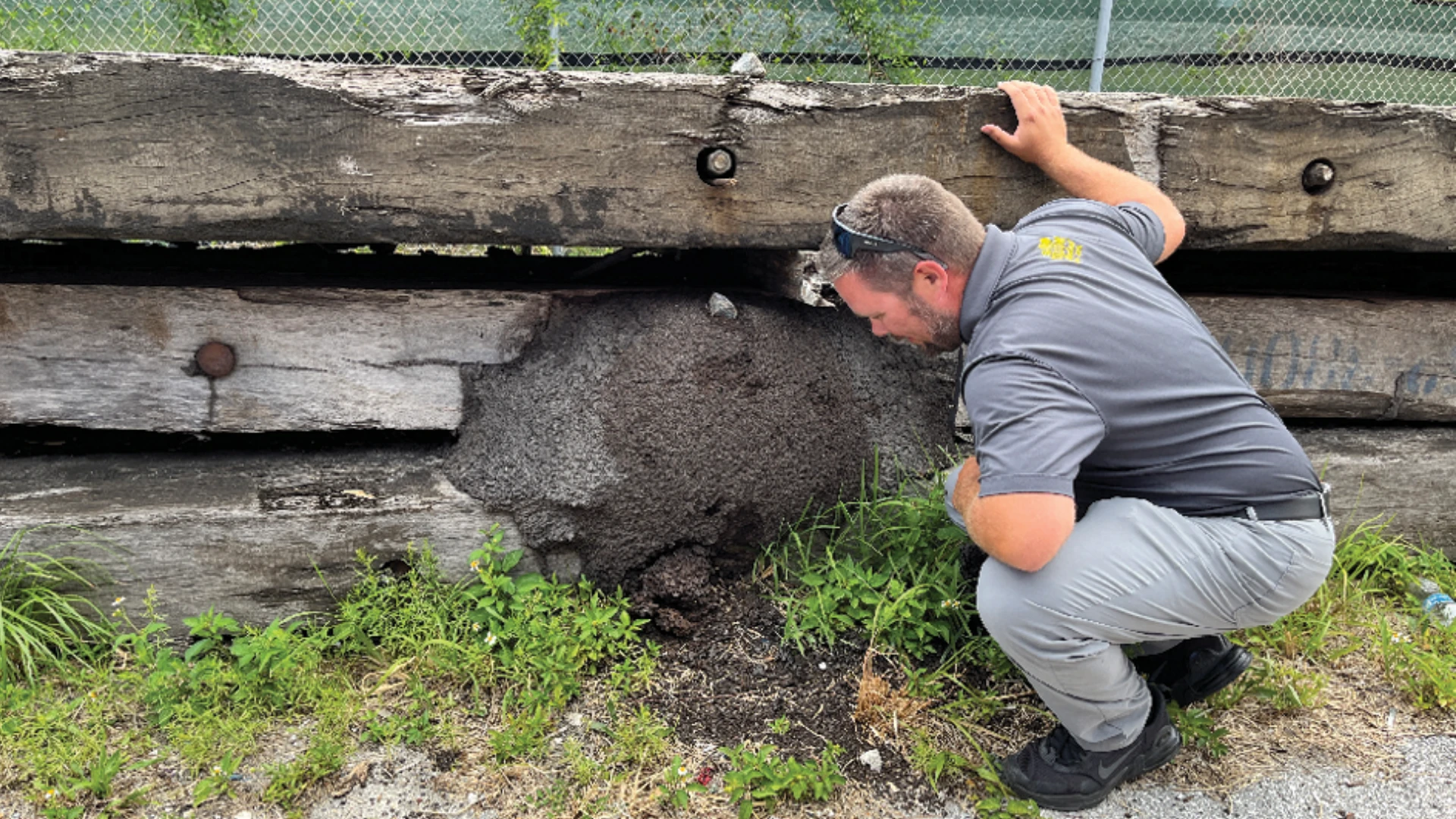This is the story of the yellow sac spider, the only household pest with a particular affinity for my nose. But before I get into that, we need to place this remarkable creature in context. Also called the “yellow house spider,” the common name actually refers to two nearly identical, pale yellow species.
Chiracanthium inclusum is a ubiquitous native arachnid, about ¼-inch in length, which is found throughout North and South America. C. mildei is a slightly larger introduced species from Europe and the Middle East that also has become widespread, particularly in urban areas. The genus Chiracanthium is in the family Clubionidae (the sac spiders), whose members are all active hunters that do not use silk to capture their prey.
NIGHT RUNNER. The yellow sac spider rarely moves about during the day unless disturbed. But when it starts searching at twilight, the restless energy of this arboreal wanderer is impressive. “Walking” is not in its vocabulary. Its nights are spent racing over vegetation, waving its long forelegs like antennae to test its way. When it gets to the top of a leaf or twig, it lets out a length of silk that floats wherever the breeze takes it. As soon as the line adheres to something solid, the hunter rapidly crosses the gap on it and resumes its running.
Why are these spiders so common indoors? For one, they’re often so common outdoors. A large portion of those anonymous silken strands that cover your shrubs or lightly brush across your face in the morning are clubionid lines.
Second, when the spiders are seeking shelter they become strongly thigmotactic, preferring narrow crevices that touch them on all sides. Particularly in the fall, when they follow the thermal gradient under doors, around windows, and through hundreds of tiny openings in a building’s outer shell, they’re a hard pest to keep out. This is one of the two times when they’re most often seen inside. The other is in the spring, when they awake from overwintering.
Once indoors, yellow sac spiders remain true to their penchant for climbing. Most types of household spiders are found on or near the floor. Chiracanthium typically heads upwards and sooner or later winds up on or near the ceiling. I have seen apartments infested with them on the 10th floor of a high-rise, although most of them probably got to that level by “ballooning” – playing out a silk line that doesn’t snag anything and eventually lifts the spider up into the wind.
How do you prevent and control them? Although trimming vegetation away from a building is a good idea in general, I can’t see that it really makes all that much of a difference for this pest. Other than paying scrupulous attention to sealing up potential points of entry, the most effective control for sac spiders is to give them the nozzle — the vacuum nozzle. (You weren’t seriously thinking about spraying them, were you?)
BORN TO BITE. The characteristic nervous energy that the yellow sac spider displays when hunting also translates into a disconcerting readiness to bite.
Once a Chiracanthium has been touched (typically by people who are either sleeping or dressing), its response is reflexive and instantaneous. The fangs are often vigorously worked into the skin and become fixed in the victim. In fact, the first report of a human bite by C. inclusum noted that the spider’s mouthparts were so firmly imbedded that a slight pull was needed to detach it. Another account related how a C. mildei, which was being held over a laboratory guinea pig that slipped free, fell on the rodent’s flank, inserted its fangs, and remained in place for eight minutes. There are also records of yellow sac spiders repeatedly biting as they crawl over a person’s skin.
Clearly, these are animals that don’t like to be messed with.
What gives added significance to the bites is the necrotic lesions that some of them produce. Sensitivity to Chiracanth-ium venom varies widely. For many, the effect is no worse than the proverbial bee sting. For an unlucky few, there may be nausea, severe pain in the general area of the bite, and a sunken area of dead skin the size of a quarter that takes months to heal. At this end of the spectrum, the bite resembles the work of a brown recluse spider (Loxosceles spp). Aided by the misdiagnoses of medical personnel playing entomologists, close encounters with Chiracanthium are probably a major contributing factor to the “recluse spider hysteria” often associated with unwitnessed bites that become necrotic.
SABOTAGE BY SAC. The sac that gives clubionids their common name is an oval silken tube, about an inch long, that the spider constructs as a daytime resting cell. It may be open at one or both ends, or completely enclosed.
Resting cells are generally occupied for only a single day, then abandoned when the spider resumes its nocturnal wandering. Indoors, the little white cocoons are readily seen at exposed corners and angles, such as where two walls meet or at the ceiling line, but they are much more abundant in any sort of protected crevice. Enormous numbers can accumulate over several seasons in door frames, under loose molding, or between shelving and walls.
Silk is one of the toughest, most durable proteins found in nature. Ounce for ounce, it’s supposed to be stronger than steel. The propensity of an abundant spider to weave patches of this miracle fabric in concealed locations on a nightly basis has a considerable implication for the impact of Chiracanthium on man. Which is to say, man’s technology is just full of narrow apertures that need to remain uncovered. As a result, almost every urban entomologist has encountered instances where the sac spider has thrown little silken monkey wrenches into the finely tuned workings of instruments and machines.
For example, the household smoke detector of an Indiana client was disabled by a single Chiracanthium sac in its innards, as was an outdoor weather recording instrument in Maryland and the optical sensors in several ceiling-mounted security devices that I examined in a Virginia warehouse. But the most dramatic instances of “sac-otage” involve the blockage of various gas appliances. One of Consultant Austin Frishman’s seminar props used to be a red card and small brush supplied to all customers of a gas grill manufacturer. Titled “Spider Alert,” the card read:
“Spiders spinning webs in the grill’s venturi tubes may obstruct the full flow of gas to the burner. Some gas backs up and can result in a ‘flashback’ – a fire in the venturi behind the control panel. Periodically check and clean the venturis using the brush included with this card.”
Gene Wood, another legend in urban entomology, made a detailed study of C. mildei as a pest of outdoor gas air conditioning units in Washington, D.C., from 1968-70. Overwintering spiders entered the burner box and spun sacs within the main burner orifices and pilot aeration openings, causing the units to malfunction when they were started up the following spring. Out of 9,000 air conditioners inspected by the gas company during the study, 28 percent had been infested by the spider. It was estimated that homeowners in the area were paying $25,000 per year in extra service costs for web removal (Gene Wood, unpublished data).
THE CLUBIONID CURSE. Actually, my abiding interest in the yellow sac spider has relatively little to do with its status as a saboteur. It’s something a lot more personal. You see, although I’ve been a professional urban entomologist for more than 30 years, I hate spiders with a passion. And this particular arachnid has definitely singled me out for special treatment over the years.
Like most other phobias, why an illogical and intense dislike of spiders takes root in some minds but not in others remains a mystery. But at least in my own case, there is no question about which particular aspects of spiderhood invoke the strongest response. It’s not about size or hairiness – tarantulas barely make it into the “mild” category. No, to be an “extra spicy” spider, you need to fulfill three requirements. You need long legs, quick movements, and, most of all, you need to be ON ME.
Does this sound like a spider we know? Any critter that races around madly at night is bound to become, sooner or later, a hands-on type of pest. And it’s not only the hyperactivity that increases the likelihood of contact with people, it’s the acrobatics. Yellow sac spiders are well-known danglers, dropping from ceilings on their silken line and then just hanging there (at face height!), contemplating whether or not to go any further. Once in a crowded room I felt a tickle on my face, glanced down, and to my amazement saw a Chiracanthium dangling near the floor from a strand that was (I’m not making this up) attached to my nose. It started to climb back up. I swept my hand across my nose, snagged its line, and for a few memorable seconds was the only person in that room with a sac spider yo-yo.
My most memorable clubionid encounter was also nose-related, and took place several years ago when I was driving a beat-up van to work. I lived near a wood lot that was a seething hotbed of sac spider activity, and would start out on my morning drive long before sunup. I liked that old junker, but one of its flaws was that its rubber door seals had worn down to the point where any determined spider could enter at will. And then, for some reason, they would wind up running around on the inside of the windshield. I’d be driving down the highway, minding my own business, when all of a sudden I’d have my own private spider TV, silhouetted on the glass by the oncoming headlights.
This happened dozens of times over the years. Sometimes I’d risk disaster by taking a wadded-up tissue and crushing the little demon at 60 mph, hanging onto the wheel with one hand and trying to split my concentration equally between my quarry and the road. Other times I’d mellow out and wait until I was safely parked at my destination to strike. This was possible because the spider normally did not leave the glass.
Then one morning as I was barreling along, waiting for one of my windshield runners to get within range, I realized the spider had disappeared.
This was not good. They hardly ever did that, and you could bet it wasn’t because the darn thing had curled up for a nap. It was now truly a loose cannon. But what were the chances it would actually get on me? And even if it did, I’d never even realize it in the dark, and it would just keep on going. Right?
Wrong. All of a sudden, I realized the spider was running over my face. And before that second of shock had a chance to turn to panic, I felt it go up my nose!
What would you do? I snorted like a horse with all the force I could muster, knowing I had only a split second to blow it out of there before it felt trapped and began biting. It worked! I kept control of the vehicle. I lived to tell the tale. And though I searched the van thoroughly afterwards, I never did find that *&%$# spider.
Yes, I was the victor that time. But I know it was just one more skirmish in a never-ending war. Because as long as the Curse Of The Clubionid is on me, who knows when the next challenge will be?
The author is regional entomologist for the U.S. General Services Administration in Washington, D.C. He can be reached via e-mail at agreene@pctonline.com.

Explore the October 2002 Issue
Check out more from this issue and find your next story to read.
Latest from Pest Control Technology
- The Evolving World of Electronic Rodent Monitoring
- Back-to-basics Approach for Cockroach Control
- PPMA Encourages PMPs to Take Part in Termite Awareness Week
- Moneypenny is a Provider of Virtual Receptionists
- Video: Top 10 PCT Photo Contest Finalists
- Massey Services Expands with Southeast Commercial Region
- Pest Management Foundation Announces Kevin J. Burns Scholarship
- How to Identify Clover Mites





